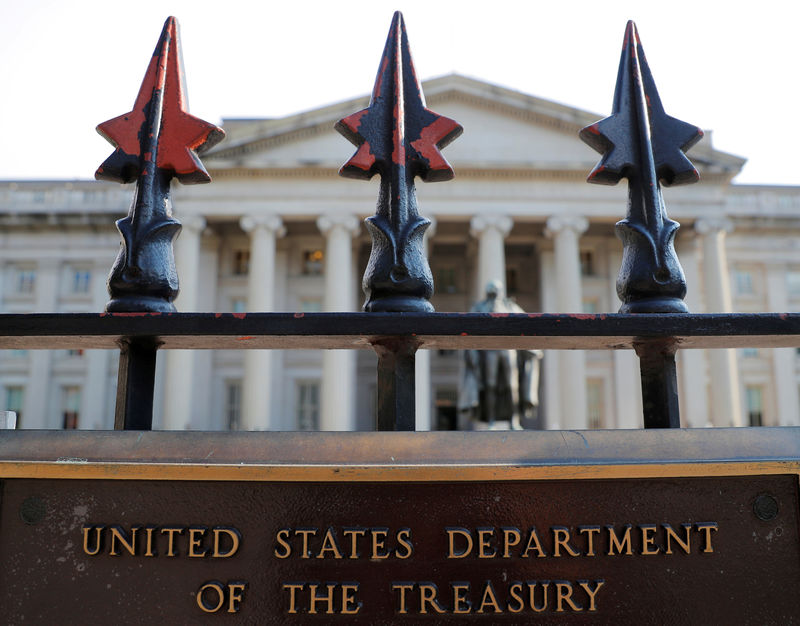(Bloomberg) -- The Treasury market’s top-performing trade is under threat as the U.S. and China appear to be closing in on a partial trade deal, boosting prospects for global growth and quicker inflation.
U.S. government debt due in a decade or more has returned more than 15% this year through Nov. 5, on track for its biggest annual gain since 2014, according to a Bloomberg Barclays (LON:BARC) index. But the performance has started to fizzle, with the measure extending declines to a third straight month as 10- and 30-year yields touch the highest since September. And investors will be keenly focused on the longer end of the curve this week, with the U.S. Treasury preparing to sell 10-year debt on Wednesday and 30-year bonds the day after.
The recent sell-off in longer maturities may simply be the result of investors trying to lock in returns as 2019 draws to a close, according to Morgan Stanley (NYSE:MS) Investment Management. Duration -- the longer it is, the bigger the gains when yields fall -- has been the biggest contributor to fixed-income returns “bar none,” said portfolio manager Jim Caron.
“If duration giveth, duration taketh away,” Caron said. “If rates go back up, you’re going to find that people will be very quick to try and preserve those gains.”
Rates on 30-year Treasuries climbed as high as 2.35% Tuesday, up from a record low of 1.9% touched in August as angst over the global ripple effects of trade friction spread and inflation expectations tumbled. They were at 2.32% in early U.S. trading Wednesday.
Benchmark 10-year yields, which touched a high of 1.87% on Tuesday, are around 1.84%, up from a three-year low of 1.43% set in early September. Ten-year yields are still down more than 80 basis points in 2019, compared with a drop of close to 70 basis points for the long bond.
Bonds around the globe have mirrored the recent move in Treasuries, with yields on 10-year German bunds rising 43 basis points from a September low. A similar Australian benchmark has also climbed more than 40 basis points from its August trough.
Caron says the U.S. economic outlook argues for the 10-year yield to be closer to 2%, a level last seen in August. He’s been reducing duration in his portfolios since early October.
Surprisingly strong U.S. services data released Tuesday and optimism that the Trump administration may remove tariffs on Chinese goods prompted traders to dial back Federal Reserve rate-cut expectations. Market-based measures of inflation expectations are on the rise again, and the yield curve is steepening.
Auction Pressure
The back-up in longer-dated yields comes as the U.S. prepares to auction a combined $46 billion of 10- and 30-year bonds Wednesday and Thursday.
The supply of Treasuries should widen the gap between 5- and 30-year yields, according to JPMorgan Chase (NYSE:JPM) & Co. rates strategist Jay Barry. He estimates that from current levels around 67 basis points, the curve is roughly 15 basis points too flat.
“It’s natural that as the Street and investors make room for the longer-duration supply that comes in the middle of the month, the curve steepens in anticipation,” Barry said.
A similar trend has also been seen in Japan. Yields on 10-year Japanese sovereign bonds climbed to the highest in more than five months on Wednesday after weaker-than-expected demand at a 2.1 trillion yen ($19 billion) auction.
“Higher yields could become a trend if the U.S.-China trade talks continue to progress,” said Tadashi Matsukawa, head of fixed-income investment at PineBridge Investments Japan Co.
In U.S. credit meanwhile, investment-grade bond deals non-financial issuershave also been targeting longer maturities. The average for new deals in the market Tuesday was about 26 years, up from 15 years on Monday, and about 13 years for this year so far.Consolidated Edison (NYSE:ED) placed a bigger than expected $600 million in 40-year bonds tight to its existing curve.
Double Down
Not everyone is convinced higher yields are in the offing. For one thing, a trade accord between the U.S. and China is hardly a done deal.
TD Securities strategists recommend “doubling down” on long 10-year Treasury positions, targeting a drop in yields to 1.6%.
“Global growth and trade uncertainty remain headwinds” despite recent positive headlines, analysts Priya Misra and Gennadiy Goldberg wrote in a Tuesday note. “Foreign inflows this year have been the highest since 2012, and low global rates suggests these flows are unlikely to abate.”
Brown Advisory’s Thomas Graff sees long bonds losing regardless of whether the economic outlook brightens or worsens from here. On the one hand, it’s unlikely that inflation expectations will surge and buoy longer yields. But at the same time, the 30-year probably won’t rally as much as shorter maturities should the Fed be forced to cut rates meaningfully in the months ahead.
For that reason, he’s underweight the longest parts of the curve.
“If you have a lot in the 30-year, I feel like you’re vulnerable on both ends,” said Graff, head of fixed-income at the $6.2 billion asset manager.
(Updates with credit market issuance)
